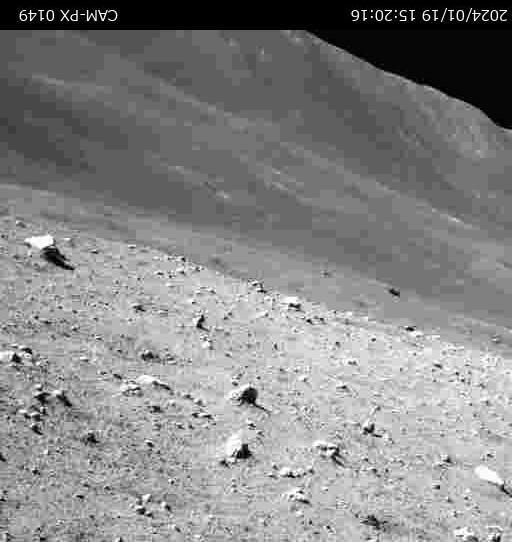Mystery solved – Japan’s SLIM Moon probe landed on its nose
Thanks to a pair of tiny lunar rovers, the mystery of Japan’s crippled SLIM Moon lander has been solved. Images returned by the two robots show that the spacecraft bounced and is sitting on its nose, preventing its solar panels from charging.
When JAXA’s SLIM spacecraft touched down on the Moon on January 19, 2024, it was a real cause for Japan to celebrate. Not only was the country the fifth to successfully land on our satellite, it did so with an unprecedented degree of precision. Unfortunately, while the lander was intact and its systems were operating as predicted, the solar panels weren’t charging the battery, giving SLIM only hours to live.
To prevent a premature end to the mission, JAXA engineers ordered the lander to power down into sleep mode while the problem was addressed. By a stroke of good fortune, SLIM had deployed two tiny rovers called Lunar Excursion Vehicle 1 (LEV-1) and Sora-Q before landing.
JAXA
Shaped like a toy ball, Sora-Q has a camera aboard, which it used to take images of the landing area and of SLIM. It then relayed the images back to Mission Control using LEV-1, which has a powerful enough transmitter to directly contact Earth, though at a very low data rate.
The result of these images was to show that SLIM was sitting on its nose with the solar panel pointing west. The attitude is probably the result of the lander bouncing on impact in the low lunar gravity.
The good news is that the mission is continuing and JAXA hopes that the lander will be able to charge its battery as the 14-day lunar day progresses enough for sunlight to fall on the panel.
“[T]he accomplishment of Lev-1’s leaping movements on the lunar surface, inter-robot communication between Lev-1 and Sora-Q, and fully autonomous operations represent ground-breaking achievement,” said JAXA in a statement. “It would be regarded as a valuable technology demonstration for future lunar explorations, and the acquired knowledge and experience will be applied in upcoming missions.”
Source: JAXA
Thanks to a pair of tiny lunar rovers, the mystery of Japan’s crippled SLIM Moon lander has been solved. Images returned by the two robots show that the spacecraft bounced and is sitting on its nose, preventing its solar panels from charging.
When JAXA’s SLIM spacecraft touched down on the Moon on January 19, 2024, it was a real cause for Japan to celebrate. Not only was the country the fifth to successfully land on our satellite, it did so with an unprecedented degree of precision. Unfortunately, while the lander was intact and its systems were operating as predicted, the solar panels weren’t charging the battery, giving SLIM only hours to live.
To prevent a premature end to the mission, JAXA engineers ordered the lander to power down into sleep mode while the problem was addressed. By a stroke of good fortune, SLIM had deployed two tiny rovers called Lunar Excursion Vehicle 1 (LEV-1) and Sora-Q before landing.

JAXA
Shaped like a toy ball, Sora-Q has a camera aboard, which it used to take images of the landing area and of SLIM. It then relayed the images back to Mission Control using LEV-1, which has a powerful enough transmitter to directly contact Earth, though at a very low data rate.
The result of these images was to show that SLIM was sitting on its nose with the solar panel pointing west. The attitude is probably the result of the lander bouncing on impact in the low lunar gravity.
The good news is that the mission is continuing and JAXA hopes that the lander will be able to charge its battery as the 14-day lunar day progresses enough for sunlight to fall on the panel.
“[T]he accomplishment of Lev-1’s leaping movements on the lunar surface, inter-robot communication between Lev-1 and Sora-Q, and fully autonomous operations represent ground-breaking achievement,” said JAXA in a statement. “It would be regarded as a valuable technology demonstration for future lunar explorations, and the acquired knowledge and experience will be applied in upcoming missions.”
Source: JAXA
